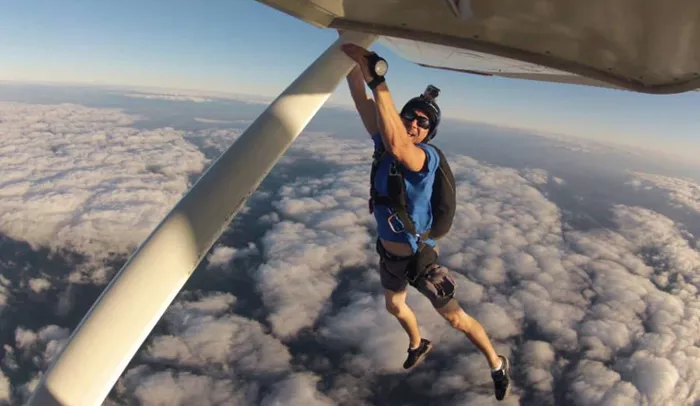Skydiving is one of the most thrilling extreme sports in the world. It gives people a unique chance to experience what it feels like to fly. But when you hear the term “freefall” in skydiving, you might wonder: Are you really free falling? What does freefall mean in skydiving? This article will explain everything you need to know about freefall during a skydive in a clear and simple way.
What Is Freefall in Skydiving?
Freefall is the part of the skydive when you jump out of the airplane and fall through the air without your parachute open. During this time, you are not attached to anything except your instructor (in tandem jumps) or your own body if you jump solo. You are literally falling freely through the sky, feeling the wind rushing past you.
The word “freefall” means you are falling under the force of gravity alone, without any support or restraint. In skydiving, this means you are falling with nothing slowing you down except the air resistance pushing against your body. You are not connected to the plane anymore, and your parachute is still packed and unopened.
How Does Freefall Work Physically?
When you first leave the plane, gravity pulls you down, and you start to speed up. At the same time, air pushes up against you. At first, gravity is stronger, so you accelerate. But after about 8 to 10 seconds, you reach what is called “terminal velocity.” This means the air resistance pushing up equals the force of gravity pulling you down. At this point, you stop speeding up and fall at a constant speed.
For most skydivers, terminal velocity is about 120 miles per hour (around 193 kilometers per hour) when falling belly-to-earth. This speed can change depending on your body position and weight. For example, if you dive head-first, you can fall faster because you have less air resistance.
How Long Does Freefall Last?
The length of freefall depends on how high you jump from and when you open your parachute. Most skydives start from around 10,000 to 15,000 feet above the ground. Usually, skydivers open their parachutes at about 5,000 feet.
If you jump from 14,000 feet and open your parachute at 5,000 feet, you freefall for about 9,000 feet. This takes roughly 40 to 60 seconds, depending on your speed and body position. The first 1,000 feet takes about 10 seconds to fall, and after that, you fall about 5 seconds per 1,000 feet.
What Does Freefall Feel Like?
The feeling of freefall is often described as pure freedom. When you first leave the plane, you might feel a brief sensation of falling or dropping. Then, as you reach terminal velocity, the feeling changes. It feels like you are flying in a strong wind tunnel, with the air pushing up against your body.
Some people find the wind so strong it makes breathing feel harder, but you can breathe normally during freefall. It is an incredible adrenaline rush and a moment of total excitement and awe.
The Three Phases of a Skydive
Skydiving is not just about freefall. The whole jump has three main parts:
1. Freefall
This is the exciting part when you jump out and fall freely through the sky before opening your parachute.
2. Parachute Opening
At a safe altitude, your instructor or you will open the parachute. This slows your descent dramatically and allows you to control your landing.
3. Landing
The final phase is landing safely on the ground, guided by the parachute.
Many people love the adrenaline of freefall, while others enjoy the peaceful glide under the parachute. Both parts are important and unforgettable.
Why Do People Skydive?
People skydive for many reasons. Some want to challenge themselves and face their fears. Others want to experience the thrill of flying and the unique sensation of freefall. It is also a way to enjoy breathtaking views from high above the earth.
Freefall is the core of the skydiving experience because it gives you a feeling that no other sport can match—the feeling of flying freely through the sky.
Safety in Freefall
Skydiving is a safe sport when done with professional instructors and proper equipment. In tandem jumps, a trained instructor controls the jump and parachute deployment. They know exactly when to open the parachute and how to handle emergencies.
During freefall, you are securely attached to your instructor if you are a beginner. This ensures your safety while you enjoy the experience. After the parachute opens, the descent slows down, making landing safe and controlled.
Conclusion
Freefall in skydiving means falling through the air without your parachute open. You start freefall the moment you exit the plane and continue until your parachute opens. Gravity pulls you down, and air resistance pushes up. After about 8 seconds, you reach terminal velocity, falling at a steady speed of about 120 mph. Freefall usually lasts between 30 to 60 seconds depending on jump altitude and parachute deployment height.
The feeling of freefall is like flying in a strong wind tunnel, an exciting and unique sensation.
Skydiving has three phases: freefall, parachute opening, and landing. Safety is ensured by professional instructors and reliable equipment, especially for beginners.
Freefall is the heart of skydiving. It is the moment when you truly feel free, flying through the sky with nothing holding you back. Whether you are a first-timer or an experienced jumper, freefall offers an unforgettable experience that combines physics, adrenaline, and the joy of flight.

